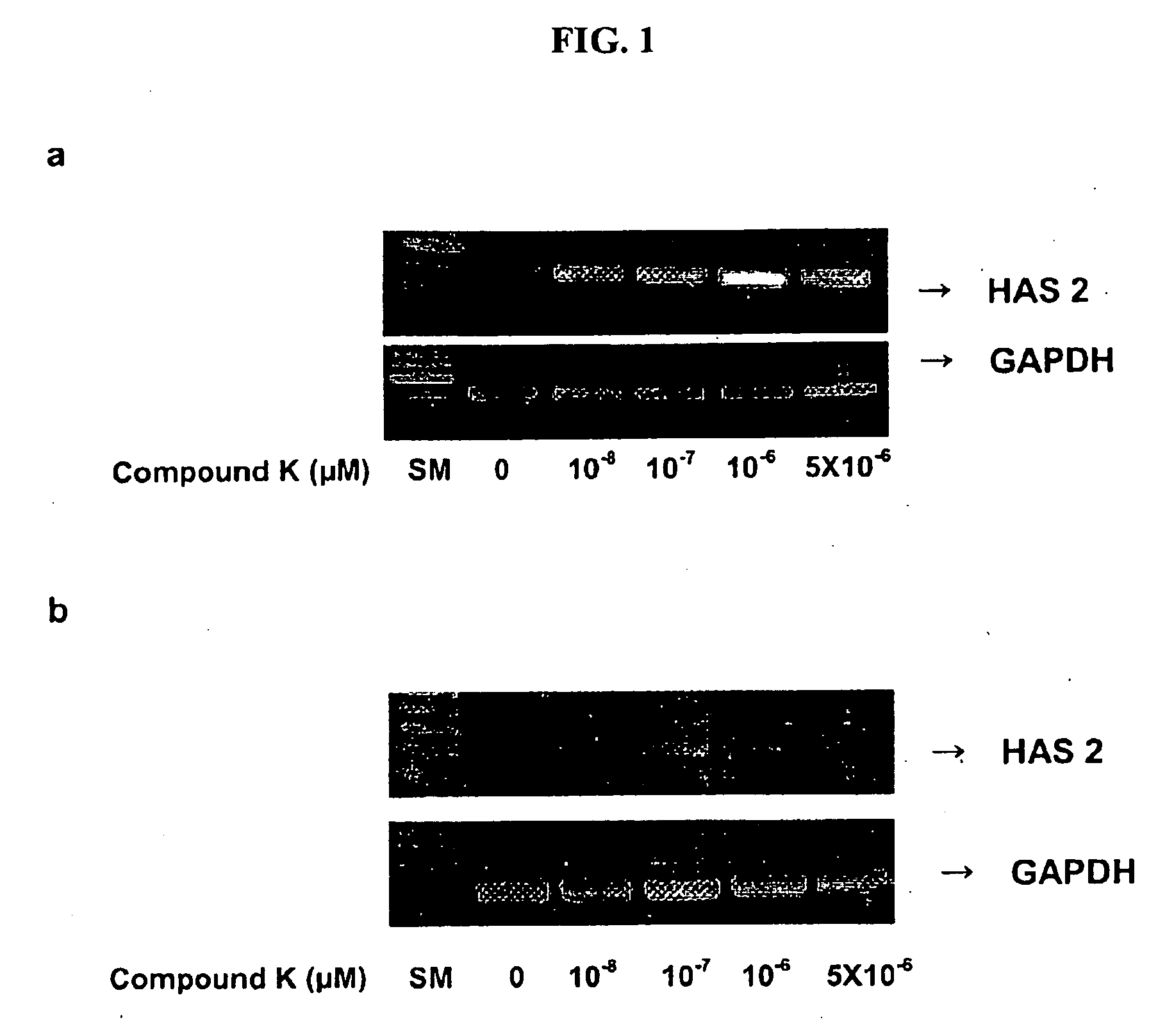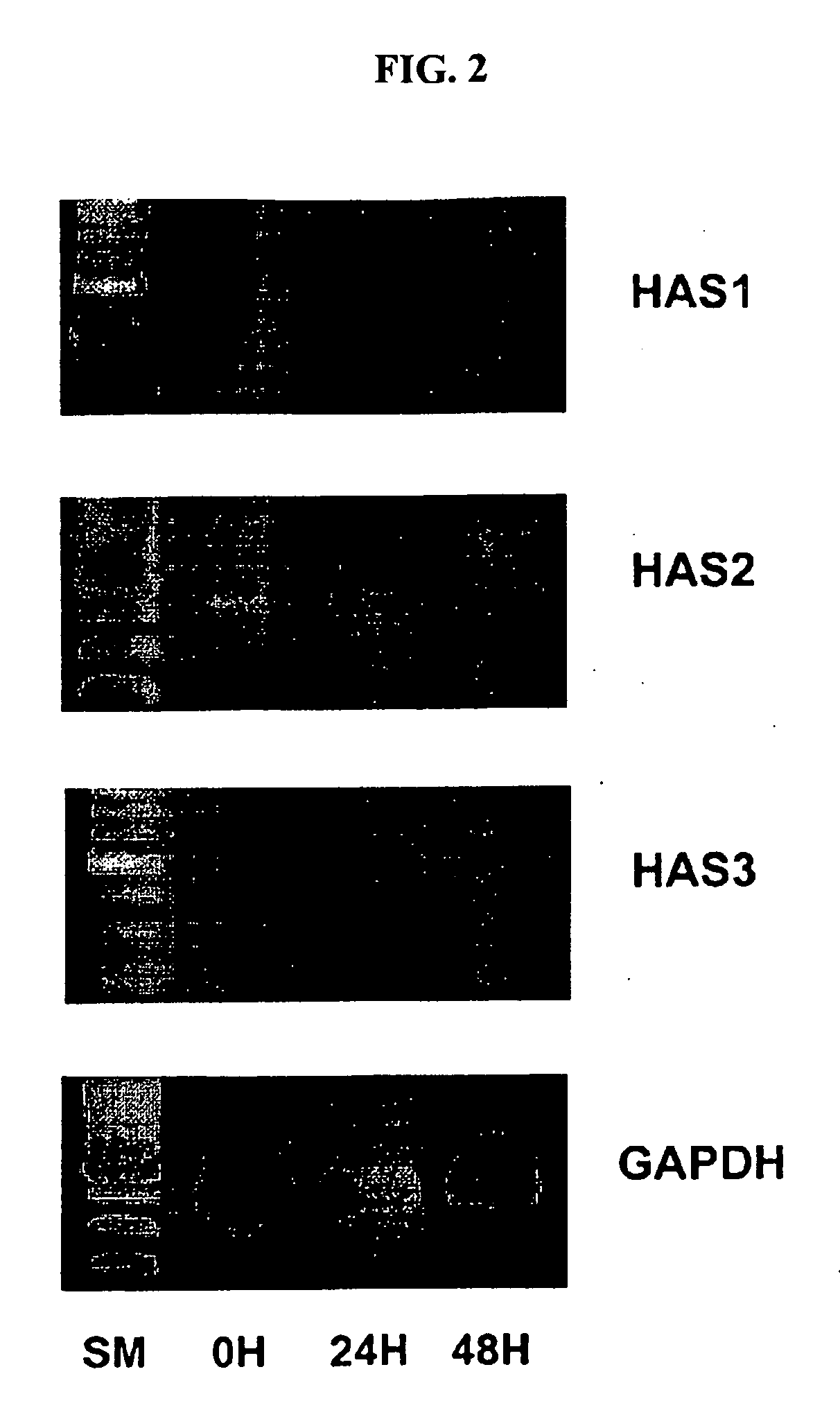Promoter For The Production Of Hyaluronic Acid Containing Ginsenoside Compound K
a technology of ginsenoside and hyaluronic acid, which is applied in the direction of biocide, drug composition, antibiotics, etc., can solve the problems of accelerating cartilage damage, hyaluronic acid metabolism mechanism has not been fully elucidated, and studies on the distribution of hyaluronic acid in cells and tissues, etc., to prevent skin dryness, improve skin elasticity, and prevent osteoarthritis
- Summary
- Abstract
- Description
- Claims
- Application Information
AI Technical Summary
Benefits of technology
Problems solved by technology
Method used
Image
Examples
example 1
Preparation of Compound K
[0029]10 g of ginseng extract (red ginseng, white ginseng and the root hair and leaf of ginseng) was dissolved in 2 l of citrate buffer (pH 4.0). Thereto was added 10 g of naringinase (Sigma, St. Louis, Mo.), 10 g of pectinase (Novozyme, Copenhagen, Denmark) then the mixture was cultured in 38° C. of water bath for 48 hours. After enzymetic hydrolysis was completed, the reaction mixture was extracted with 2 l of ethylacetate and then evaporated under a vacuum condition to give 2.8 g of residue. For purification of compound K, the obtained product was subjected to silica gel column chromatography, eluted with chloroform- methanol (9:1) and then with chloroform-methanol (6:1), to give 0.28 g of pure compound K.
experimental example 1
Effect of compound K on HAS2 gene expression in human epidermal cell line HaCaT
[0030]
[0031]Spontaneously immortalized human keratinocyte cell line, HaCaT, was provided by Dr. N. E. Fusenig (Deutsches Krebsforschungszentrum(DKFZ), Heidelberg, Germany) and human diploid fibroblast cell line, HDF, was provided by Dr. S. C. Park (Seoul National University, Seoul, Korea).
[0032]The cells were cultured in Dulbecco's modified Eagle's medium (DMEM) supplemented with 10% fetal bovine serum (HyClone), sodium bicarbonate (3.6 g / l) and antibiotics of streptomycin (100 μg / ml) and penicillin (100 U / ml) (Life Technologies, Inc.) at 37° C. in a humidified atmosphere containing 5% CO2 and 95% air. The culture was changed with fresh medium every 3 days. On reaching the maximum cell-density, the cells were recultured at a 1:5 division ratio. 48 hours before treatment with compound K, the cells were seeded into a tissue culture flask at 1×105 cells per 75 cm2 and cultured in the medium with 10% fetal bo...
experimental example 2
Effect of compound K on production of hyaluronic acid in human epidermal and dermal cell lines
[0040]HaCaT and HDF cells were washed with PBS then fixed in a fixative with 2% paraformaldehyde(v / v) and 0.5% glutaraldehyde(v / v) at room temperature for 20 min. After fixation, the cells were washed three times for 2 min each with 0.1 M sodium phosphate buffer (pH7.4), then blocked in 1% bovine serum albumin (w / v) containing 0.1% Triton X-100 (v / v) in the same buffer at room temperature for 30 min. Hyaluronan staining was carried out with a specific probe of biotinylated hyaluronan binding protein (bHABP) (Seikagaku, Tokyo, Japan). The bHABP probe, diluted to 5 μg / ml in 3% bovine serum albumin (w / v), was added to the fixed cells and was incubated overnight at 4° C. After washing, avidin-fluorescein isothocyanate (FITC) was added. Images were analyzed with fluorescent microscope and are shown in FIG. 3.
[0041]FIG. 3 shows the effect of compound K on the distribution of hyaluronic acid in th...
PUM
| Property | Measurement | Unit |
|---|---|---|
| pH | aaaaa | aaaaa |
| humidity | aaaaa | aaaaa |
| temperature | aaaaa | aaaaa |
Abstract
Description
Claims
Application Information
 Login to View More
Login to View More - R&D
- Intellectual Property
- Life Sciences
- Materials
- Tech Scout
- Unparalleled Data Quality
- Higher Quality Content
- 60% Fewer Hallucinations
Browse by: Latest US Patents, China's latest patents, Technical Efficacy Thesaurus, Application Domain, Technology Topic, Popular Technical Reports.
© 2025 PatSnap. All rights reserved.Legal|Privacy policy|Modern Slavery Act Transparency Statement|Sitemap|About US| Contact US: help@patsnap.com



